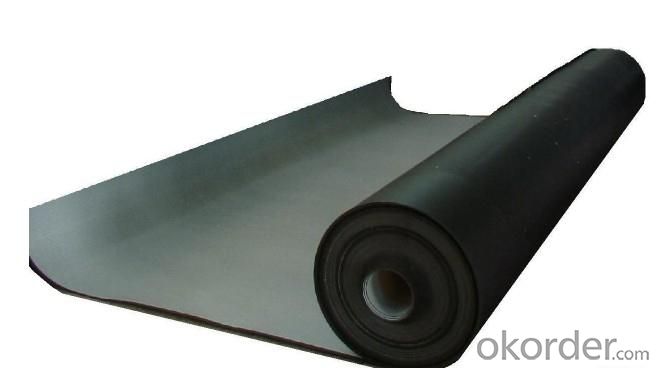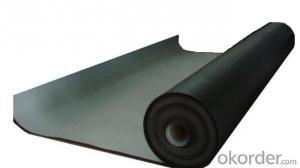Self-adhesion rubber asphalt waterproofing membrane
- Loading Port:
- China main port
- Payment Terms:
- TT OR LC
- Min Order Qty:
- 10000 m²
- Supply Capability:
- 300000 m²/month
OKorder Service Pledge
OKorder Financial Service
You Might Also Like
1.Structure of Self-adhesion rubber asphalt waterproofing membrane Description:
Self-adhesion rubber asphalt waterproofing membrane is based on SBS elastomer and asphalt base makings, to polyethylene film, aluminum foil as the surface material or film (double-sided adhesive), adopting the anti-sticking layer of self-adhesive waterproof material. Since the sticky rubber asphalt waterproof coiled material is a kind of have broad prospects for development of new building waterproof material, has excellent waterproofness, low temperature flexibility and extensibility, caking. Especially it has self-healing, this is generally do not have the advantages of waterproof material, can ensure the quality of waterproof engineering super waterproof.
2.Main Features of Self-adhesion rubber asphalt waterproofing membrane:
The elasticity of rubber, excellent elongation.
Excellent sticky relay at the base
Construction safety, no pollution and easy construction
A self-healing, corrosion resistance.
3.Self-adhesion rubber asphalt waterproofing membrane Specification:
| P | PY | |||
| Tensile Strength(N/5mm) | 500 | 800 | ||
| Tear strength/N | 400 | 200 | ||
| Elongation at break,% | 400 | - | ||
| Flexibilty at low temperature | -25℃,No crack |
4.Self-adhesion rubber asphalt waterproofing membrane Images:

- Q:Can waterproofing membranes be installed on uneven surfaces?
- Waterproofing membranes possess the capability to be installed on surfaces that are not even. In reality, one of the benefits of these membranes is their ability to adapt to different irregularities and unevenness on the surface. Typically, these membranes are flexible and can be easily shaped and adjusted to fit the contours of the substrate. Furthermore, certain waterproofing membranes possess self-adhesive properties or can be applied with adhesives, enabling them to effectively stick to both smooth and uneven surfaces. Nevertheless, it is crucial to emphasize that proper surface preparation is essential for a successful installation. The surface must be clean, dry, and devoid of any loose materials or debris to ensure the optimum adhesion and performance of the waterproofing membrane.
- Q:Can waterproofing membranes be used on outdoor patios?
- Yes, waterproofing membranes can be used on outdoor patios. They are an effective way to protect the patio from water damage and can help to prevent leaks and moisture penetration. Waterproofing membranes create a barrier between the patio surface and water, keeping it dry and extending its lifespan.
- Q:Basement SBS Waterproof Coil Division I and II type What is the difference? How is the site identified?
- Type I low temperature flexibility is -20 degrees, pulling force of 500N / 5cm, elongation of 30%. Type II low temperature is -25 degrees, tension of 800N / 5cm, elongation of 40%. The appearance of the general can not distinguish, you can take the sample to the laboratory to be a tensile test on it.
- Q:Are waterproofing membranes resistant to earthquake movements?
- Waterproofing membranes serve the purpose of safeguarding structures, such as buildings and basements, from the invasion of water and moisture. While they effectively prevent water damage, they are not specifically engineered to withstand or endure the movements caused by earthquakes. Earthquakes involve the shaking and displacement of the ground, which exert considerable forces on structures. Waterproofing membranes do not typically possess the ability to absorb or distribute these forces in the same manner as seismic-resistant materials or building techniques. Nevertheless, it is important to note that certain waterproofing systems may exhibit a certain level of flexibility or elasticity, which could potentially offer some resistance against minor ground movements during an earthquake. These characteristics may assist in maintaining the integrity of the membrane and preventing water infiltration if slight shifting or settling occurs. Ultimately, when it comes to earthquake resistance, it is vital to employ specialized seismic design principles and techniques that are suitable for the specific location and building requirements. In order to ensure overall structural integrity and safety during seismic events, waterproofing membranes should be utilized in conjunction with these seismic-resistant measures.
- Q:Can a waterproofing membrane be used in elevator pits?
- Yes, a waterproofing membrane can be used in elevator pits. Elevator pits are vulnerable to water damage and moisture accumulation, so applying a waterproofing membrane can help prevent water intrusion and protect the elevator components from potential damage.
- Q:Can a waterproofing membrane be used on concrete?
- Concrete can indeed benefit from the use of a waterproofing membrane. In fact, it is a popular technique employed to shield concrete structures from the harmful effects of water and moisture. A waterproofing membrane is a slender layer of material that is carefully placed on the concrete surface, serving as a barrier against water and moisture. This membrane can be crafted from a variety of materials such as bitumen, rubberized asphalt, polyurethane, or acrylic. It is typically administered in either liquid or sheet form, effectively attaching itself to the surface and forming a continuous impermeable coating. This coating, in turn, prevents water from infiltrating the concrete, thereby thwarting the possibility of deterioration, cracks, and other types of damage. Waterproofing membranes are extensively employed in a wide range of concrete applications, including basements, foundations, roofs, and any other structures that are exposed to water or moisture.
- Q:Can waterproofing membranes be used on foundation walls?
- Indeed, it is possible to utilize waterproofing membranes on foundation walls. These membranes possess a specific design that aims to impede the infiltration of water and are commonly employed on foundation walls to safeguard against moisture and water-related harm. Typically, these membranes consist of resilient materials like rubberized asphalt, thermoplastic, or PVC, which exhibit durability and resistance to water penetration. The installation of these membranes occurs on the outer side of the foundation walls, thereby serving as a highly efficient barrier against water, effectively averting its seepage into the basement or crawl space. Without a doubt, waterproofing membranes constitute an indispensable element in the realm of building construction, as they actively contribute to the preservation of the foundation's structural integrity, preventing adverse consequences such as water damage, mold growth, and foundation settlement.
- Q:Can a waterproofing membrane protect against mold or mildew growth?
- Yes, a waterproofing membrane can help prevent mold or mildew growth by creating a barrier that keeps moisture out. By stopping water infiltration, it reduces the conditions necessary for mold and mildew to thrive, thus providing protection against their growth.
- Q:Can a waterproofing membrane be used on tunnels with water drainage systems?
- Yes, a waterproofing membrane can be used on tunnels with water drainage systems. The membrane acts as a barrier, preventing water from penetrating the tunnel structure and directing it towards the drainage system for proper disposal. This helps to ensure the integrity and longevity of the tunnel while effectively managing water flow.
- Q:Can waterproofing membranes be used on concrete block walls?
- Yes, waterproofing membranes can be used on concrete block walls. In fact, it is often recommended to use waterproofing membranes on concrete block walls to prevent water infiltration and moisture damage. Waterproofing membranes are designed to create a barrier against water and can be applied to the exterior or interior surface of the concrete block walls. These membranes provide an additional layer of protection, preventing moisture from seeping into the walls and causing issues such as mold growth, efflorescence, and deterioration of the concrete blocks. By using waterproofing membranes, you can ensure the longevity and durability of your concrete block walls.
1. Manufacturer Overview |
|
|---|---|
| Location | |
| Year Established | |
| Annual Output Value | |
| Main Markets | |
| Company Certifications | |
2. Manufacturer Certificates |
|
|---|---|
| a) Certification Name | |
| Range | |
| Reference | |
| Validity Period | |
3. Manufacturer Capability |
|
|---|---|
| a)Trade Capacity | |
| Nearest Port | |
| Export Percentage | |
| No.of Employees in Trade Department | |
| Language Spoken: | |
| b)Factory Information | |
| Factory Size: | |
| No. of Production Lines | |
| Contract Manufacturing | |
| Product Price Range | |
Send your message to us
Self-adhesion rubber asphalt waterproofing membrane
- Loading Port:
- China main port
- Payment Terms:
- TT OR LC
- Min Order Qty:
- 10000 m²
- Supply Capability:
- 300000 m²/month
OKorder Service Pledge
OKorder Financial Service
Similar products
New products
Hot products
Related keywords



























